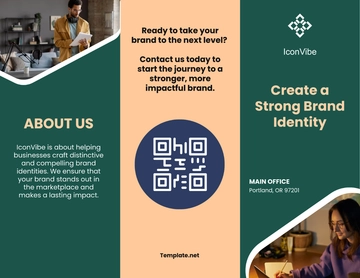Free Digital Brand Transformation Advertising Blueprint

Introduction
In today's digital age, a successful brand transformation is essential for staying competitive and relevant. This blueprint outlines the strategic steps and tactics required for [Your Company Name], a renowned e-commerce retailer specializing sustainably, to embark on a comprehensive digital brand transformation journey.
Executive Summary
A. Background
[Your Company Name], founded in 2010 by eco-conscious entrepreneurs [Your Name] and Jimmy Thompson, has made a significant impact in the fashion industry by championing sustainable practices. The company has garnered a dedicated customer base over the years. However, to adapt to evolving market dynamics and consumer expectations, [Your Company Name] recognizes the need for a brand transformation.
B. Goals and Objectives
The digital brand transformation initiative is driven by the following objectives:
Goal 1: Achieve a 30% increase in online sales within the next two years.
Goal 2: Elevate the brand's recognition and perception among the target audience to that of a global trendsetter in sustainable fashion.
Goal 3: Expand [Your Company Name]'s international market presence by successfully entering at least two new markets by 2052.
These objectives are ambitious but achievable, representing a strategic shift that [Your Company Name] is committed to undertaking.
Situation Analysis
A. Market Research
In collaboration with [Your Partner Company Name], [Your Company Name] conducted comprehensive market research to gain critical insights:
Year | Market Growth (%) | Customer Preferences | Competitor Analysis |
2050 | 8% | Growing demand for sustainable fashion | Techno Corp leading |
These findings underscore the substantial opportunity [Your Company Name] has to capitalize on the surging interest sustainably and ethically.
B. Brand Assessment
A detailed SWOT analysis of [Your Company Name] paints a comprehensive picture of its current brand position:
Strengths: [Your Company Name] boasts a strong and loyal customer base, built on ethical sourcing practices, and quality products. The company's commitment to sustainability is a significant asset.
Weaknesses: The existing website design is outdated and not optimized for user experience. Furthermore, [Your Company Name] has limited international presence, limiting its market reach.
Opportunities: There is a clear opportunity to capitalize on the growing demand for sustainable fashion and leverage [Your Company Name]'s brand ethos to expand into new markets.
Threats: As sustainability gains prominence, competition from other sustainable fashion brands, such as Ruby Clothing and Hennessy Inc., poses a threat.
Strategy Development
A. Brand Positioning
[Your Company Name] has strategically chosen to reposition itself as a trailblazer in sustainable fashion. The brand transformation will revolve around the core message of "Eco-Chic Revolution." This message encapsulates [Your Company Name]'s commitment to combining sustainability with chic, stylish designs, appealing to a broader demographic of conscious consumers.
The "Eco-Chic Revolution" positioning will emphasize the following key elements:
Ethical Sourcing: [Your Company Name] will transparently showcase its ethical sourcing practices, highlighting fair labor conditions and sustainable materials.
Innovation: [Your Company Name] will showcase its dedication to innovation by introducing cutting-edge sustainable fabrics and eco-friendly production techniques.
Fashion-forward: While sustainability is at the core, [Your Company Name] will ensure its designs are on-trend and align with current fashion trends.
Community Engagement: [Your Company Name] will actively engage with its eco-conscious community, fostering a sense of belonging and shared values.
B. Target Audience
[Your Company Name]'s target audience profiles have been meticulously crafted to align with the brand's new positioning:
Target Audience Profile
Demographics: The primary target demographic consists of women aged 25 to 40, residing in urban areas. These individuals are fashion-forward and conscious about their lifestyle choices. They lean towards eco-consciousness and prioritize sustainability in their purchasing decisions. They are tech-savvy and frequently shop online.
Psychographics: The target audience values sustainability, seeking eco-friendly products that align with their values. They prioritize fashion as a means of self-expression and take an active interest in health and fitness. Social responsibility and environmental consciousness are integral aspects of their lifestyle.
Behaviors: [Your User Name], one of the identified personas, represents this target audience. She actively engages with eco-friendly brands on social media platforms, participates in online communities promoting sustainability, and prefers mobile apps for her shopping convenience.
Advertising Campaign
A. Channel Selection
The digital brand transformation campaign will leverage a multi-channel approach to maximize reach and engagement. Key digital channels include:
Social Media: [Your Company Name] will focus on platforms like Instagram and Pinterest, where visual content can effectively convey the brand's commitment to eco-chic fashion.
Email Marketing: A targeted email campaign will be launched to engage with existing customers and keep them informed about the brand's transformation.
Paid Advertising: [Your Partner Company Name] will manage paid advertising campaigns on platforms like Google Ads and Facebook Ads to reach a wider audience.
Content Marketing: High-quality blog content and videos on sustainability, fashion trends, and eco-friendly living will be shared on [Your Company Name]'s website to attract and educate the audience.
B. Creative Content
To align with the "Eco-Chic Revolution" brand positioning, [Your Company Name] will create visually appealing and informative content. Sample content themes and key messages include:
Month | Content Theme | Key Messages |
Jan '51 | "New Year, New You" | Embrace change with [Your Company Name]'s latest sustainable fashion collection. |
Each content piece will feature high-quality images and engaging storytelling, effectively conveying the brand's commitment to sustainability and style.
Implementation Plan
A. Timeline
The implementation plan is designed to ensure a smooth and efficient execution of the digital brand transformation. It is essential to adhere to a well-structured timeline that outlines the key phases and activities:
Phase | Start Date | End Date | Key Milestones and Activities |
Research | Jan 2050 | Mar 2050 | Conduct in-depth market research and trend analysis to identify emerging sustainable fashion trends and consumer preferences. |
Strategy | Finalize brand positioning as "Eco-Chic Revolution. | ||
Campaign Launch | Create marketing materials, including website redesign, social media assets, and email campaigns. Continuously analyze data to assess campaign performance and make real-time adjustments for optimization. | ||
Monitoring | Implement advanced tracking and monitoring systems to collect data on website traffic, customer engagement, and conversion rates. Continuously analyze data to assess campaign performance and make real-time adjustments for optimization. |
B. Budget
Proper allocation of the budget is vital to ensure that each phase of the transformation has the necessary resources for success. Here is a breakdown of the budget allocation:
Phase | Budget Allocation | Sample Expenses |
Research | $50,000 | Market research fees, data collection tools, research team salaries. |
Strategy | Strategy development, content creation, agency fees. | |
Campaign Launch | Website redesign, social media advertising, email marketing, creative production. | |
Monitoring | Analytics tools, monitoring software, data analysis. |
Reporting
Regular reporting is essential to track progress and make informed decisions. Monthly reports will be generated and shared with key stakeholders, including [Your Partner Company Name]. Each report will encompass:
Performance Metrics: An overview of KPIs and their progress toward achieving the set targets, with a detailed breakdown of website traffic, conversion rates, and social media engagement.
Campaign Analytics: In-depth insights into the performance of individual campaigns and marketing channels, highlighting strengths and areas for improvement.
Customer Feedback: Gathering and analyzing customer feedback to identify trends, preferences, and areas where the brand can enhance its offering.
Recommendations: Actionable recommendations for adjustments and optimizations based on performance data, ensuring a continuous improvement cycle.
Conclusion
A. Key Takeaways
[Your Company Name] has recognized the need for a comprehensive digital brand transformation to remain competitive and resonate with evolving consumer preferences.
The "Eco-Chic Revolution" brand positioning, emphasizing sustainability and style, will be the cornerstone of this transformation.
A carefully planned timeline and budget allocation will ensure efficient execution.
Measuring success through key performance indicators (KPIs) and continuous reporting will guide data-driven decisions.
B. Next Steps
As we move forward in the digital brand transformation journey, here are the immediate next steps:
Execute the Strategy: Begin implementing the brand transformation strategy as outlined in the timeline. This includes launching advertising campaigns, revamping the website, and engaging with the target audience.
Monitor and Adjust: Continuously monitor campaign performance and customer feedback. Be prepared to adjust strategies and tactics based on real-time data to optimize results.
Expand Internationally: Work on entering two new international markets as part of the global expansion objective.
Engage with clients and users: Regularly involve your clients and users, representing the voice of the target audience, for feedback and insights.
Regular Reporting: Share monthly reports with key stakeholders to ensure transparency and alignment with objectives.
- 100% Customizable, free editor
- Access 1 Million+ Templates, photo’s & graphics
- Download or share as a template
- Click and replace photos, graphics, text, backgrounds
- Resize, crop, AI write & more
- Access advanced editor
Unleash your brand's digital potential with Template.net's Digital Brand Transformation Advertising Blueprint Template. This editable and customizable tool, powered by our Ai Editor Tool, facilitates strategic planning for brand evolution in the digital landscape. Elevate your advertising strategy by outlining actionable steps to enhance brand presence and engagement online.





























